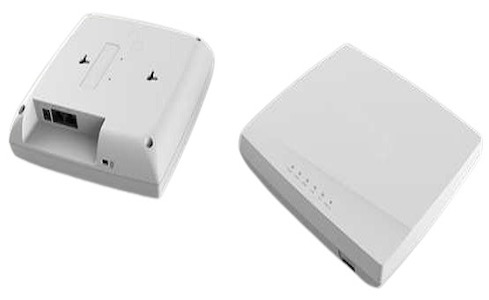VAP7718A
VAP7718A is a Tri-band 802.11ac wave2 access point., the 2.4G frequency band supports 2×2 MIMO and 2 spatial streams; the 5G frequency band supports two radio frequencies, and one 5G radio frequency supports 2×2 MIMO and 2 spatial streams, the other 5G radio supports 4×4 MIMO and 4 spatial streams, and the overall rate is up to 3Gbps. By seamlessly working with ABLOOMY local AC (CAM), ABLOOMY private cloud (CSP) and ABLOOMY public cloud (ACS), it can build all kinds of customized, enterprise-grade wireless networks through an approach which combines simplicity, scalability, extensibility, reliability, performance and security. It works well in any high-density Wi-Fi coverage environment, such as school, healthcare, hospitality, enterprise and shopping malls.
Highlights
Load Balancing and Band Steering
Supports load balancing based on the number of access users, traffic, and frequency bands, and the system automatically guides users to the 5GHz frequency band by default, which maximizes network capacity and ensures the best access experience for users.
Zero Touch Provisioning
Fully supports plug-and-play deployment. No matter the network environment is complex or not, whether the device is deployed in the public or private network, as long as the device can access the AC, the system can automatically complete the configuration and the network is up running without touch.
Easy Maintenance
Supports real-time monitoring AP system status and sending alarms automatically when detecting faults; supports automatic software update in the batch mode based on the policies of AP location, model, version, and the update time.
Network Security
Supports L4 stateful firewall, role-based NAC (network access control), white/black lists, URL logging, and full 802.11i security standard.
Auto Power and Auto Channel
Supports automatic Tx power adjustment to automatically detect and compensate the signal coverage; supports automatic/manual adjustment of channels to ensure that the AP is in the best radio frequency environment and provide users with the best QOS.
Hardware Specification
| Physical | Dimension(L*W*H) | 196mm*196mm48.5mm |
| Weight | 900g | |
| Port | 10/100/1000M auto negotiate (RJ45×2) | |
| Reset Button:Factory reset | ||
| DC Jack | ||
| Safety slot | ||
| LED | Indicate power-on status, start-up status, running status, alarm and fault status of the system | |
| Power | Power Input | DC:12V,2A |
| Max Consumption | PoE power supply | |
| Environment | Working Temp | 0~45℃(+32 °F to +113 °F) |
| Storage Humidity | -20℃~60℃ | |
| Working Humidity | 5%~95% non-condensing | |
| RF | Antenna | Integrated dual Omni antenna |
| Gain | 2.4G: 4dBi 5G-1: 4dBi 5G-2: 4dBi | |
| SSID (VAP) | Each SSID: 32 | |
| Max Users | 758 | |
| Max Tx | 2.4G:21dBm 5G-1:21dBm 5G-2:21dBm Subject to local regulatory requirement |
Receive Sensitivity
| RSSI(2.4GHz/5GHz)± 2dB | 2.4GHz | 5GHz |
| 11 g (6Mbps) | -93 | - |
| 11 g (54Mbps) | -76 | - |
| 11 a (6Mbps) | - | -93 |
| 11 a (54Mbps) | - | -76 |
| HT20(MSC 0/8) | -92 | -92 |
| HT20(MSC 7/15) | -73 | -71 |
| HT40(MSC 0/8) | -90 | -89 |
| HT40(MSC 7/15) | -70 | -68 |
| VHT20 MCS 9 | - | -65 |
| VHT40 MCS 9 | - | -64 |
| VHT80 MCS 9 | - | -60 |
Software Specifications
Software | |
WLAN | Comply with IEEE801.11a b/g/n/ac/ac wave2 standard Support dynamic rate adjustment Support channel automatic scanning and manual selection Support dynamic and manual power adjustment Support fast roaming protocol (802.11r 802.11k) Support Short GI in 20M, 40M, 80M mode Support WMM Support band steering Support load balancing based on AP traffic, frequency band and number of users Support Hotspot 2.0 |
Security | Support Open-system authentication method Support WEP authentication/encryption method Support WPA/WPA2-PSK authentication/encryption method Support WPA/WPA2-802.1X authentication/encryption method Support WPA-WPA2 combine Authentication method Support WPAI authentication/encryption method Support 802.1X, MAC, portal, SMS and some social-media authentication methods Support data traffic local forwarding and centralized forwarding |
Network | Support user access isolation under the same SSID Support role-based NAC (network access control) and ACL Support bandwidth control based on each user Support speed limit based on WAN port bandwidth Support network detection based on Ping and Arp Support switching AP to the standalone mode when the connection between AP and AC is lost to make sure the data traffic is not interrupted Support AC active/standby deployment Support DHCP Server Support static IP/DHCP/PPOE Support IPV6 Support Soft-GRE Support VPDN Support AP and AC deployed in the cross-Internet mode |
Management & Maintenance | Support Cloud or AC based centralized management Support Web UI Management (HTTP) Support CLI (SSH) management Support console-based management Support updating AP's local credential remotely Support Zero Touch Provisioning Support LED light control Support scheduled restart of AP Support batch modification of AP's AC access address Support software update in the batch mode based on the policies of AP location, model, version and update time Support AP status alarm |





